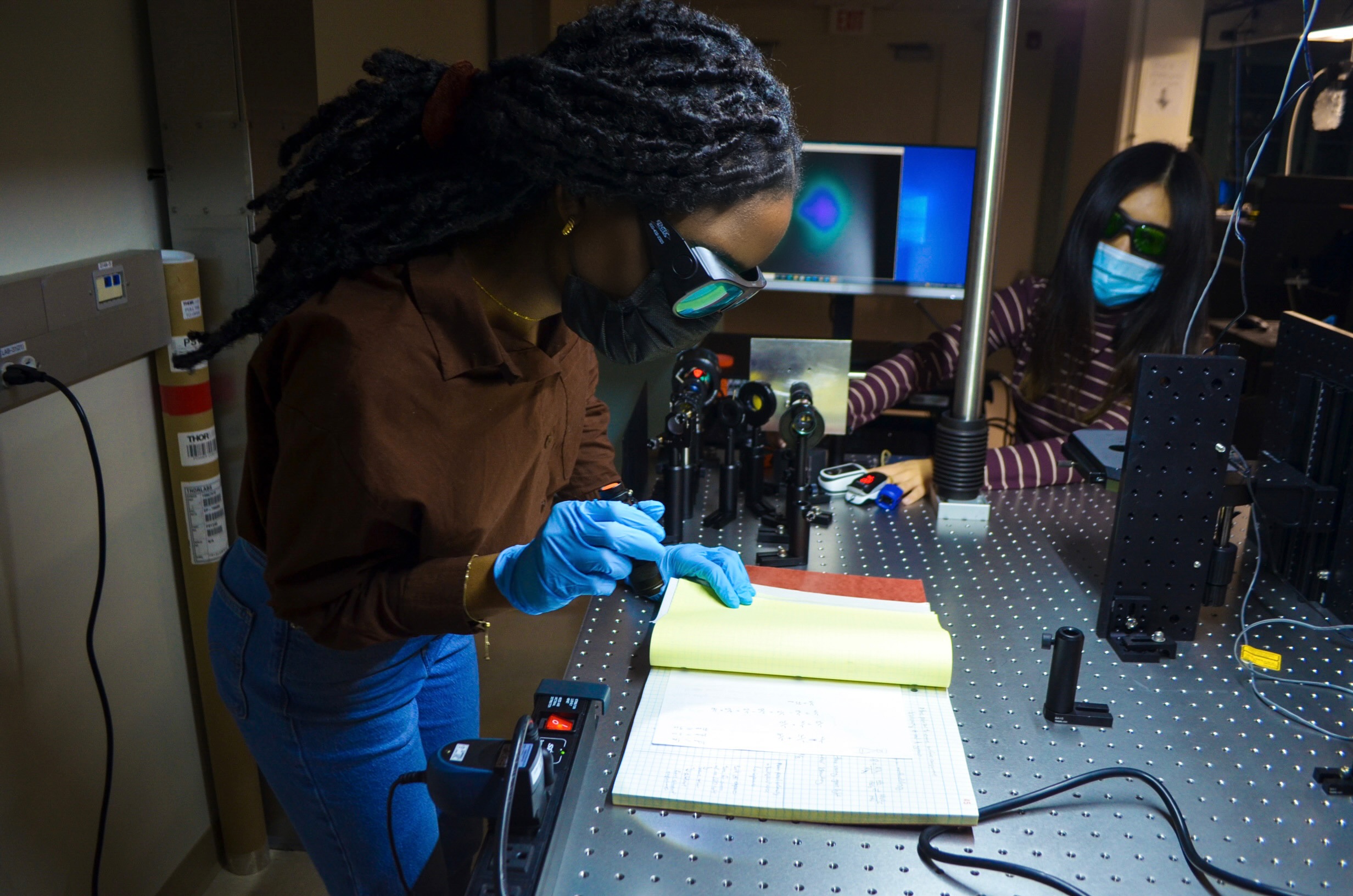
Rutendo Jakachira, a second-year Ph.D. student in Brown University’s Department of Physics, has received an inaugural Optica Foundation Amplify Scholarship. Jakachira was one of only fifteen students selected from around the world for the award, intended to “support Black students and their passion for light science.” She plans to use the funding to continue working on a non-invasive method of obtaining accurate blood oxygen readings from people across a variety of skin tones.
Optica, formerly known as The Optical Society, is a global organization dedicated to the study of optics and photonics with over 488,000 members in 183 countries. George Okyere Dwapanyin, a member of the Optica review committee, says, “The pool of candidates from over 20 countries was impressive. It was inspiring to review these researchers’ applications, learning about their passion for optics, science, and engineering. I look forward to following these careers.”
Jakachira will use the funds to continue working on a project with considerable implications for people of color around the world. For years it has been known that patients with darker skin receive less accurate blood oxygen measurements using pulse oximeters than those with lighter skin. Jakachira, in conjunction with Brown University Professor of Engineering Kimani C. Toussaint, is working to create a non-invasive method of obtaining accurate blood oxygen readings from people with darker skin.
Jakachira addresses the problem in a statement, “The severity and rapid spread of the COVID-19 virus has put a strain on healthcare systems making it difficult to provide care in the hospital to patients infected by the disease as well as patients with unrelated health issues, highlighting the importance of noninvasive and reliable health diagnostic technology, especially in the home. One health diagnostic device that currently exists is the pulse oximeter, which is used to monitor an individual’s blood oxygen levels. Pulse oximeters have seen an increase in use during the COVID-19 pandemic. However, it has been found that there can be up to a 10% difference in oxygen saturation measurements among different pulse oximeters for individuals with darker skin tones. It has also been found that people of darker skin tones are three times more likely to have hypoxemia and it is likely to be missed by pulse oximetry.”
Pulse oximeters use photonics to measure blood oxygen levels. But before a measurement can be made, the light from the device must first pass through a patient’s skin. According to Jakachira, “the amount of melanin that is present in the skin can affect how the light is scattered,” making it more difficult to obtain accurate readings on individuals with higher levels of melanin. The fact that pulse oximeters are less reliable in Black patients has been well-known in the medical community for many years but little has been done to address the problem until recently. In 1990, only a few years after the introduction of pulse oximetry, researchers published a study in CHEST Journal that reported that pulse oximetry was almost two and a half times less accurate in mechanically ventilated Black patients.
Investigation of the problem has intensified since the beginning of the COVID epidemic; A recent study by researchers at Nottingham University determined that pulse oximeters provided false readings 5.8% higher for Black patients with COVID-19 than white patients. Readings were found to be nearly 7% higher for patients of mixed ethnicity. Dr. Andrew Fogarty, the lead author of the study, said, “This data builds on what we know, which is that patients with darker skin have less accurate oxygen measurements using the pulse oximeters. Any error of measurement of oxygen levels will make assessing the severity of COVID-19 infection more difficult, and may delay delivery of timely medical care.”
Pulse oximetry is an area in medicine where racial bias, whether overt or not, has had a negative impact and contributed to the documented lower quality of medical care for Black people in the United States. It’s one of many problems that led the National Academy of Medicine (NAM) to release a report in 2005 that concluded that, “racial and ethnic minorities receive lower-quality health care than white people—even when insurance status, income, age, and severity of conditions are comparable.” Jakachira and Toussaint hope to develop a device that will address that imbalance in pulse oximetry in the near future.

The problem is especially acute because pulse oximeters tend to give higher-than-accurate blood oxygen level readings on people with darker skin which is particularly hazardous for COVID patients who are being monitored remotely to determine if blood oxygen levels have dropped below a threshold that requires hospitalization. A 2020 study by researchers at the University of Michigan Medical School and published in The New England Journal of Medicine determined that “among the patients who had an oxygen saturation of 92 to 96% on pulse oximetry, an arterial oxygen saturation of less than 88%” was found in 11.7% of Black patients versus only 3.6% of white patients. Jakachira says, “This has resulted in a disproportionate number of deaths in Black and brown communities, and [Professor Toussaint and I] are trying to mitigate this issue.”
Jakachira says her background in optics, which she studied as an undergraduate at Drew University working under Professor Bjorg Larson, attracted her to the project. She explains, “Last summer I was looking for research opportunities. I was introduced to Professor Toussaint because he has an optics background, and he proposed this project to me. It was a project started by one of his past Master’s students, Teniola Oguntolu.” She adds, “I thought it was a perfect fit and happily accepted.” Beyond the intellectual challenge, Jakachira says, “it’s highly motivating to know that my Ph.D. work will help people in my community.”
Jakachira and Toussaint have developed a novel approach to the problem that Jakachira recently presented at the SPIE Photonics West BiOS conference. Jakachira says, “It looks like our device is working.” She adds, “We did a preliminary study on about five people, and although it was a small study, the results are promising and show a signal in the noise. We are looking toward doing a study on a larger population group, and the next step would be a clinical trial.”
For his part, Professor Toussaint has been impressed with Jakachira’s work. He says, “Rutendo has approached this project with a combination of dedication, ingenuity, and strong interest. This has allowed us to gain a better understanding of the problem in terms of the underlying optical physics, and to creatively think outside of the box in developing a solution.” Jakachira says she is “very happy and grateful to have received this award," and believes it will push her to complete the work. She says she is “very grateful” to Professor Toussaint for guiding her in this project and also to the Department of Physics and Professor Stephon Alexander in particular for his ongoing mentoring efforts.